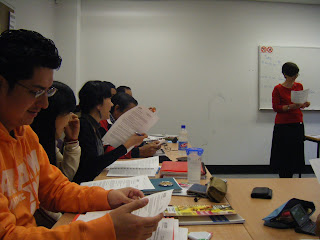วันอังคารนี้ตุ๊กได้เข้าไปนั่งดูและช่วยสอนวิชาภาษาอังกฤษใน 2 ระดับที่แตกต่างกัน ในช่วงเช้าตุ๊กได้เข้าไปดูภาษาอังกฤษสำหรับนักเรียนที่ภาษาอังกฤษอยู่ขั้นดีมาก นักเรียนส่วนใหญ่ผ่านเข้ามาระดับนี้เพราะกำลังจะเรียนในระดับมหาวิทยาลัยอีกไม่กี่เดือนที่จะถึง นักเรียนส่วนใหญ่ฝึกฝนทักษะการคิด การเขียนในระดับมหาวิทยาลัย นักเรียนส่วนใหญ่กำลังจะเรียนในระดับปริญญาโท ปริญญาตรี และปริญญาเอก นักเรียนหลายคนคิดเห็นว่าโปรแกรมนี้ทำให้พวกเขาได้พัฒนาการเขียนขั้นสูงได้เป็นอย่างมาก ไม่กี่คนเท่านั้นที่คิดว่าตัวเองไม่ได้พัฒนาอะไรเลย ตรงนี้เองที่ตุ๊กขออนุญาตอาจารย์ผู้สอนเพื่ออธิบายเนื่องจากตุ๊กเคยมีประสบการณ์การเรียนในต่างประเทศมาก่อน แต่แตกต่างตรงที่ตุ๊กไม่ได้เรียนโปรแกรมเหมือนกับนักเรียนกลุ่มนี้เลย พวกเขาโชคดีมาก ตุ๊กอธิบายว่าตุ๊กต้องเรียนหนักกว่าคนอื่นถึง 3 เท่า การที่ได้เรียนเนื้อหาที่ได้เรียนมาแล้วนั้นใช่ว่าเราไม่ได้เรียนอะไรแล้ว แต่ที่จริงแล้วเรากำลังลับทักษะ และความรู้ของเราให้แหลมคมมากยิ่งขึ้น นักเรียนในชั้นหลายคนเห็นด้วย
การสอนของอาจารย์ที่สอนในรายวิชานี้ค่อนข้างจะเป็นแบบผู้ช่วยให้คำปรึกษาเท่านั้น อาจารย์จะอธิบายหลักการต้นชั่วโมงแล้วจะให้งานที่เตรียมมาให้นักเรียนทำ ให้นักเรียนคุยและปรึกษากันเอง ในขณะที่อาจารย์จะอยู่ห่างๆ คอยสำรวจว่าใครกำลังมีปัญหา เมื่อเห็นว่านักเรียนคนไหนมีปัญหาอาจารย์เขาก็จะเข้าไปนั่งคุยและให้คำอธิบาย สิ่งที่อาจารย์ท่านนี้ทำอย่างประจำคือเขียนลงบนบอร์ดว่าวันนี้เขาจะทำอะไรบ้างในห้องเรียน เพื่อที่นักเรียนจะได้ทราบว่าในวันนั้นจะเรียนเรื่องอะไรบ้าง ส่วนกิจกรรมที่ทำในห้องเรียนนั้น บางครั้งอาจารย์ก็จะเซอร์ไพรซ์นักเรียน
สิ่งที่ได้เรียนรู้หลังจากที่ได้เปรียบเทียบการสอนในระดับสูง กับระดับต่ำลงมานั้นทำให้รู้ว่าคนที่เป็นอาจารย์ควรจะทราบว่านักเรียนของตนอยู่ในระดับใด เขาต้องการเรียนรู้และพัฒนาทักษะในส่วนใด ซึ่งอาจารย์ก็จะเตรียมกิจกรรมและเปลี่ยนแปลงการสอนของตนเองให้เหมาะสมกับความต้องการและจำเป็นกับตัวนักเรียน อย่างหนึ่งที่ต้องจำคือพยายามเซอร์ไพรซ์นักเรียนในการนำเสนอบทเรียน แตกต่างกันแล้วแต่ความเหมาะสม กับบรรยากาศของห้องเรียนในแต่ละครั้ง ที่สำคัญอีกอย่างคือต้องเตรียมกิจกรรม เอกสาร แบบฝึกหัดที่จะสอนเป็นอย่างดี พยายามเตรียมแบบฝึกหัดให้เยอะไว้ เพราะบางครั้งนักเรียนทำกิจกรรมหรือแบบฝึกหัดเสร็จก่อนหมดเวลาสนอ ดังนั้นต้องเตรียมเผื่อเอาไว้
นอกจากนี้วันนี้ในห้องพักอาจารย์ได้มีเจ้าหน้าที่นำเองกล่องสำหรับใส่กระดาษรีไซเคิลมาวางไว้ข้างๆโต๊ะอาจารย์ ตุ๊กคิดว่าเป็นความคิดที่ดีมาก ถ้าเรานำมาใช้ที่มหาวิทยาลัยศรีปทุมก็คงจะดีเพราะแม่บ้านจะได้ไม่ต้องเสียเวลามาแยกกระดาษให้กับอาจารย์ ที่นี่เขาให้ความสำคัญกับบรรยากาศในที่ทำงาน และพยายามรักษาสภาพแวดล้อมเป็นอย่างมาก
Tuesday 17 June 2008. Today I observed classes and assisted the teachers in two different levels. Obviously, I had a chance to compare the teaching styles, classroom environments and activities given to the students. My take for this is that a certain strategy/teaching style suits a certain group of students (their needs and the nature of learning) and the purposes of certain courses.
The first class was DEP (Direct Entry Program)-students placed in the this level are those who got an offer from the University, and yet with a condition to attend an academic program, or those who have a high placement score, yet the IELTS test is unsatisfatory. Thus, taking this program will enhance their academic skills and be able to enter the university when they pass the program's exit exams. Basically, this program is aimed to prompt students to academic learning as well as to mirror the Australian environment in a classroom setting.
Students practice their critical thinking, reading and writing and research preparation. Practically, there are 4 subjects that students have to take in this program (similar to real life academic learning). Today, students had Critical Thinking and Research Preparation subjects with Patricia, who invited me to join her class. In this class, the teacher totally works as a facilitator since the students are very advanced in their English skills. Throughout the class, she employed "Study" and "Activate" practice ("Engage" was less performed in the class among the teacher and the students. It's more like students and students engagement). She started the class by giving out a class schedule for the day, thus students acknowledged what would happen or what topics and activities would be covered. In the first two hours, Patricia and the students worked on an essay structure emphasised on Introduction and Synthesis. Since these students have a bit of prior knowledge from their previous levels;hence, she handed out a couple of sheets of introductions from different essays and had students individually identify the structure of each sample introduction. Later on, she asked them to discuss with their friends. Meanwhile, she observed their responses and reactions with their friends and visited each group for feedback. Here, I saw the dynamic of the classroom interaction among students. As a whole class, they analyzed the introductions and ask questions. I assisted the class a bit in summarizing the topic about writing an essay based on my previous experience as a graduate myself.
Towards the end of the class, Patricia spared some time for a discussion on the program so that the students and I could exchange feedback about the program. Also, I discussed with the teacher about her ways of teaching. She explained that she liked to step back while students discussed on an assigned task in peers or in groups;then she would observe, ask questions and explain the answers and subject matters being discussed. As for the students, many of them, who are from GE and EAP background found the program very useful and vital in terms of practicing their critical thinking and academic writing. In contrast, a few said that they hardly learned any thing from the class since they had prior knowledge from Pre-DEP class. My constructive inputs/criticism on the feedback from both sides were shared: (1) Based on my past experience, taking this course is most beneficial to them. I started my studies as the only international student with completely ZERO American environment including ZERO Literature, Teaching and Linguistics backgrounds. I had no preparation for academic studies and research writing. I was treated as one of the mainstreams and was assumed that I already knew how to write a 10-page paper. I had to learn every thing from scratch by myself and with the help of my best friend in the class. These students are fortunate to get exposed to the learning culture.
(2) As for those who thought they have learned a bit from the class, I tried to pinpoint that they are actually learning some thing and by being in the class working on their writing, they are sharpening their learning skills. Many students found that there were more interactions among peers in the class, compared to their previous classes in the lower levels, and less with the teacher and vice versa. They understand that it's because of the curricula and the purposes of the programs that have an impact on the classroom environment. As for me, in the lower levels (GE program), English language is to Study while the teacher is as an entertainer and a facilitator; versus the upper levels (such as DEP), language is a tool to help them in academic studies (they learn on how to learn or learning by doing) while the teacher is mainly a facilitator to guide on students.
What I get out from this class observation and participation are: students are informed each class what they will learn and do, teacher surprises them with activities and students produce a product towards the end of the course while the process of doing it is continuously introduced throughout the course. In brief, as for this particular level and program, the teaching is an act of guiding and facilitating--students build up their knowledge on prior experience.
(GE class experience to be continued on the next blog)
Tuesday, June 17, 2008
Different Strategies for Different Learning Purposes!
Subscribe to:
Post Comments (Atom)





No comments:
Post a Comment